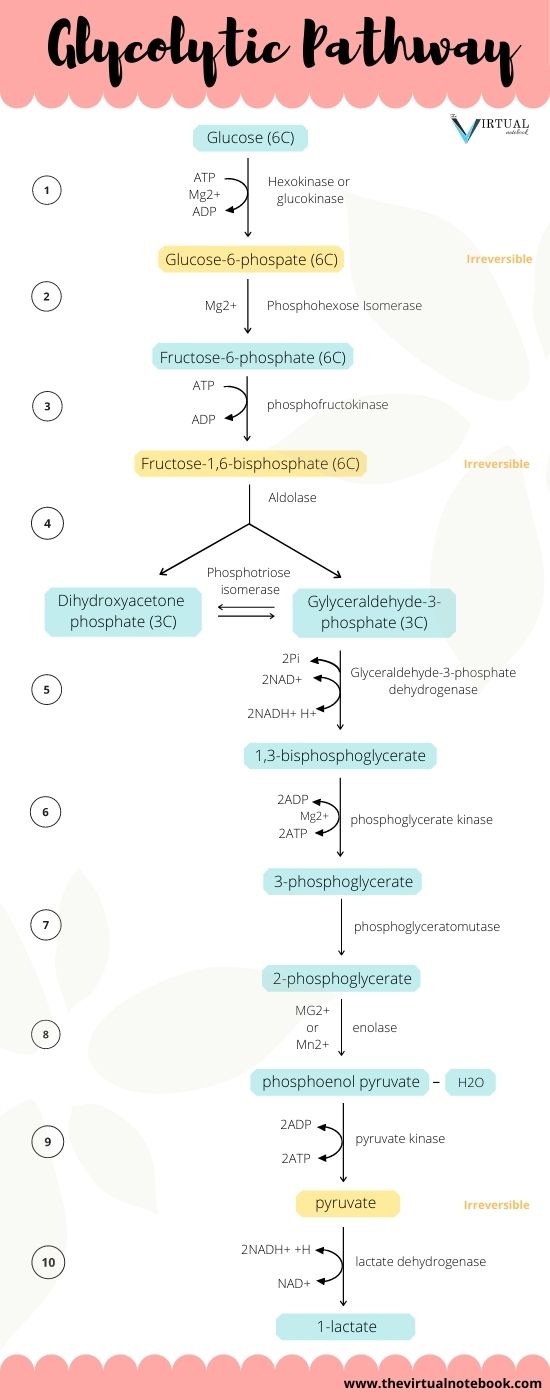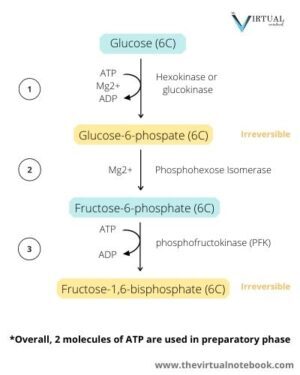WHAT IS GLYCOLYSIS?
Glycolysis is the major pathway for glucose metabolism in which glucose will convert to pyruvate (under aerobic condition) or lactate (anaerobic). Afterwards, Pyruvate can be completely oxidized to CO2 and H2O by enzymes present in the mitochondria. Glycolysis occurs in the cytoplasm of the cell and completes in a series of ten reactions. Moreover, it is a central metabolic pathway with many of its intermediates providing branch points to other pathways. Thus, the intermediates of glycolysis are useful for the synthesis of amino acids and fat.
The word ‘Glycolysis’, derived from the Greek words, ‘glykys‘ which means sweet; and ‘lysis‘ which means splitting. Hence, glycolysis technically means ‘splitting of sugar’ or ‘breakdown of sugar’. Basically, it occurs in the cytosol of all the cells and also known as “Embden-Meyerhof-Parnas pathway“.
Is glycolysis aerobic or anaerobic?
Glycolysis can occur as both aerobic and anaerobic depending on the availability of oxygen and the electron transport chain. Indeed, glycolysis is an oxygen-independent metabolic pathway. Although, it can also proceed under poor oxygen concentration. Pyruvate is the end product of aerobic glycolysis whereas lactate will produce under anaerobic glycolysis. Anaerobic glycolysis takes place in erythrocytes, cornea, lens and regions of the retina.
SIGNIFICANCE OF GLYCOLYSIS
- It takes place in all the cells of the body. Hence, it is the only pathway that occurs in all cells.
- Glycolysis is both the principal route for glucose metabolism and also the main pathway for the metabolism of fructose, galactose, and other carbohydrates derived from the diet.
- Also, anaerobic glycolysis forms the major source of energy for muscles when there is a lack or insufficient amount of oxygen is present.
- Most of the reactions of the glycolytic pathway are reversible, which are also used for gluconeogenesis.
- Glycolysis is the only source of energy in cells that lacks mitochondria. For example, erythrocytes, cornea, lens and regions of the retina.
- Moreover, it is a pathway through which the largest flux of carbon occurs in most cells. It provides carbon skeletons for synthesis of non-essential amino acids as well as glycerol part of fat.
Glycolysis VS gluconeogenesis
Glycolysis and gluconeogenesis are two pathways of glucose metabolism. One is the breakdown of glucose while the other is the synthesis of glucose. Gluconeogenesis closely resembles the reversed pathway of glycolysis, although it is not a complete reversal of glycolysis.
I wrote a separate article on glycolysis vs gluconeogenesis where I discuss similarities and differences between glycolysis and gluconeogenesis. If you would like to check, see: Glycolysis vs gluconeogenesis
GLYCOLYSIS CYCLE
Glucose transporter-4 (GluT4) transports glucose from the extracellular fluid to muscle cells and adipocytes. This translocase is under the influence of insulin. In diabetes mellitus, insulin deficiency hinders the entry of glucose into the peripheral cells. Insulin does not significantly stimulate the transport of glucose into tissues such as the liver, brain, and red blood cells. In such cases, GluT2 is the transporter.
Chiefly, glycolysis completes in a series of total ten steps. The conversion of glucose to pyruvate occurs in broadly two phases:
- Energy investment phase
- Preparatory phase
- Splitting phase
- Energy generation phase
- Oxidoreduction phase
GLYCOLYSIS STEPS
1. Energy investment phase
It involves the first four reactions of glycolysis in which intermediates (phosphorylated) synthesized at the expense of ATP. Overall, this phase requires two molecules of ATP.
1.1 Preparatory phase
Basically, it involves the first 3 reactions of the glycolytic cycle and requires two molecules of ATP.
STEP 1: Phosphorylation of glucose to glucose-6-phosphate (G6P)
The enzyme involved: hexokinase( in all tissues) and glucokinase (in liver and pancreas).
Reaction: glucose phosphorylates to glucose-6-phosphate in the presence of hexokinase which splits the ATP into ADP. Eventually, ATP molecule act as a phosphate donor in this reaction.
Points to remember: Hexokinase is inhibited allosterically by its product, glucose 6-phosphate. Hence, this reaction is irreversible.
STEP 2: Isomerization of G6P to fructose-6-phosphate (F6P)
The enzyme involved: phosphohexose isomerase or you can say phosphoglucose isomerase.
Reaction: glucose-6-phosphate will isomerize to fructose-6-phosphate by phosphohexose isomerase.
Points to remember: this reaction is readily reversible.
STEP 3: Phosphorylation of F6P to fructose-1,6-bisphosphate (F-1,6-bisP)
The enzyme involved: Phosphofructokinase (PFK).
Reaction: fructose-6-phosphate will further phosphorylate to fructose-1,6-bisphosphate. The enzyme phosphofructokinase catalyzes the second phosphorylation step of glycolysis using a second molecule of ATP.
Points to remember: PFK is an inducible, allosteric and regulatory enzyme. Evidently, it is the most important control point and committed step of glycolysis. Once again, the reaction is irreversible.

1.2 Splitting phase
STEP 4: Cleavage of fructose-1,6-bisphosphate (F-1,6-bisP) to triose phosphate
The enzyme involved: aldolase.
Reaction: fructose-1,6-bisphosphate (6C) cleaves into glyceraldehyde-3-phosphate (3C) and dihydroxyacetone phosphate (DHAP) (3C).
Glyceraldehyde 3-phosphate and dihydroxyacetone phosphate are interconverted by the enzyme phosphotriose isomerase.
Points to remember: the reaction is reversible. This reaction accomplished in two steps. Firstly, F-1,6-bisP cleaves into two triose phosphate. After that, DHAP isomerizes into glyceraldehyde-3-phosphate. Thus up to this point, we get two molecules of glyceraldehyde-3-phosphate from one molecule of glucose at the expense of 2 ATP molecules.

2. Energy generation phase
The remaining reactions will come under this phase in which a net of two molecules of ATP will form by substrate-level phosphorylation per glucose molecule metabolized.
2.1 Oxidoreduction phase
STEP 5:Oxidation and phosphorylation of glyceraldehyde-3-phosphate to (1,3-BPG)
The enzyme involved: glyceraldehyde-3-phosphate dehydrogenase.
Reaction: Glyceraldehyde-3-phosphate oxidizes and simultaneously phosphorylates to 1,3-bisphosphoglycerate (1,3-BPG) with the help of NAD+.
Points to remember: the reaction is reversible and the product contains a high energy bond. During this reaction, an aldehyde (glyceraldehyde 3phosphate) will oxidize to a carboxylic acid with the reduction of NAD+ to NADH.
STEP 6: 1,3-BPG converts to 3-phosphoglycerate (3PG)
The enzyme involved: phosphoglycerate kinase.
Reaction:1,3-Bisphosphoglycerate reacts with ADP to produce 3-phosphoglycerate and ATP.
Points to remember: it is an example of substrate-level phosphorylation. Meanwhile, two molecules of ATP will form at this stage per molecule of glucose undergoing glycolysis.
STEP 7: Isomerization of 3PG to 2-phosphoglycerate (2PG)
The enzyme involved: phosphoglyceromutase.
Reaction: 3-phosphoglycerate isomerizes to 2-phosphoglycerate.
Points to remember: the reaction is reversible.
STEP 8: Dehydration of 2PG to phosphoenol pyruvate (PEP)
The enzyme involved: enolase
Reaction: the dehydration of 2-phosphoglycerate results in the formation of phosphoenolpyruvate with the elimination of water molecules. As a result, a high-energy phosphate bond will form.
Points to remember: enolase requires Mg2+ or Mn2+ and if we remove magnesium ions, fluoride will irreversibly inhibit this enzyme. Thus, fluoride will stop the whole glycolysis. Therefore, fluoride is added to the blood while collecting blood for sugar estimation. If not, glucose is metabolized by the blood cells, so that lower blood sugar values are obtained.
STEP 9: Dephosphorylation of PEP to pyruvate
The enzyme involved: pyruvate kinase.
Reaction: this reaction completes in two steps. Firstly, PEP converts into enol pyruvate intermediate. After that, it will spontaneously isomerize into keto pyruvate, the stable form of pyruvate.
Points to remember: pyruvate kinase is a key glycolytic enzyme and it is the third irreversible reaction. Also, this is another example of substrate-level phosphorylation.
STEP 10: Reduction of pyruvate to lactate
The enzyme involved: lactate dehydrogenase.
Reaction: under anaerobic conditions, pyruvate reduces to lactate.
Points to remember: in aerobic conditions, the pyruvate enters the Krebs cycle for complete oxidation.
For more information: see Krebs cycle/citric acid cycle/ TCA cycle

GLYCOLYSIS END PRODUCT
In one cycle, glycolysis yields two molecules of pyruvate, two ATPs, two NADH and two water molecule.
Net reaction of glycolysis
glucose + 2NAD+ + 2 Pi + 2 ADP →2pyruvate + 2 NADH + 4 H+ + 2 ATP + 2 H2O.
Product of glycolysis under anaerobic condition
Overall, when 1 mole of glucose will convert to 2 moles of pyruvate. 2 moles of ATP will be used in the process, and 4 moles of ATP produced in the subsequent reaction, for a net yield of 2 moles of ATP. There is no net production or consumption of NADH.
Product of glycolysis under aerobic conditions
The direct consumption and formation of ATP are the same as in anaerobic glycolysis. Two molecules of NADH are also produced per molecule of glucose. Ongoing aerobic glycolysis requires the oxidation of most of this NADH by the electron transport chain, producing approximately three ATP for each NADH molecule entering the chain.
GLYCOLYSIS MNEMONICS
George Gives Father Freddy Delicious Guava, Berries, (&) 3-Papaya 2 Prepare Puffy Pies.
Here, capital letters (GGFFDGB3P2PPP) stand for:
G= George
G= Give
F= Father
F= Freddy
D= Delicious
G= Guava,
B= Berries, &
3P= 3 Papaya
2P=2 (to) prepare
P= Puffy
P= Pies
GLYCOLYSIS DIAGRAM

REGULATION OF GLYCOLYSIS
The regulatory enzymes or key enzymes of glycolysis are:
- Hexokinase (glucokinase, in the liver),
- Phosphofructokinase, and
- Pyruvate kinase.
Although most of the reactions of glycolysis are reversible, three are markedly exothermic and must therefore be considered physiologically irreversible. Certainly, these reactions are the major sites of regulation of glycolysis.
Hexokinase
It phosphorylates glucose to G6P for ATP production even when blood glucose levels are low. Comparatively, hexokinase has a low Km for glucose (about 0.1 mM). Therefore, it is working near its maximum rate (Vmax), even at fasting blood glucose levels.
The enzyme is inhibited by its product (glucose-6-phosphate). Therefore, it is most active when glucose-6-phosphate is being rapidly utilized.
Phosphofructokinase
PFK is regulated by several factors. It is the most prominent regulatory enzyme in glycolysis. Generally, PFK-1 is inhibited allosterically by elevated levels of ATP, which act as an “energy-rich” signal indicating an abundance of high-energy compounds.
In addition, elevated levels of citrate, also inhibit PFK-1. Conversely, PFK-1 is activated allosterically by high concentrations of AMP, which signal that the cell’s energy stores are depleted.
Pyruvate kinase
Pyruvate kinase catalyzes an irreversible step and is a regulatory
enzyme of glycolysis. It is activated by fructose 1,6-bisphosphate and inhibited by alanine and by phosphorylation in the liver during fasting when glucagon levels are high. In addition, Insulin increases its activity whereas glucagon inhibits it.
SOURCES AND EXTERNAL LINKS
Note: page numbers may vary correspondingly upon the edition.
Textbook of biochemistry for medical students 7th edition by DM Vasudevan; Chapter 9: Major Metabolic Pathways of Glucose, page no. 108 to 120
Additionally, BRS Biochemistry 6th edition, molecular biology, and genetics by Michael A. Lieberman, PhD and Rick Ricer; chapter no. 6: carbohydrate metabolism.
Also, Lippincotts illustrated review biochemistry 6th edition; chapter 8: introduction to metabolism and glycolysis page no. 187 to 199.
Harper’s Illustrated Biochemistry 28th edition; chapter 18: glycolysis and the oxidation of pyruvate, page no. 317 to 327.
Lastly, Textbook of biochemistry with Clinical Correlations 4th edition by Thomas L Delvin page no. 274 to 278

Simple and easy to understand,
try to add very conceptual MCQ’s and their answers at the end
Great work. well done.